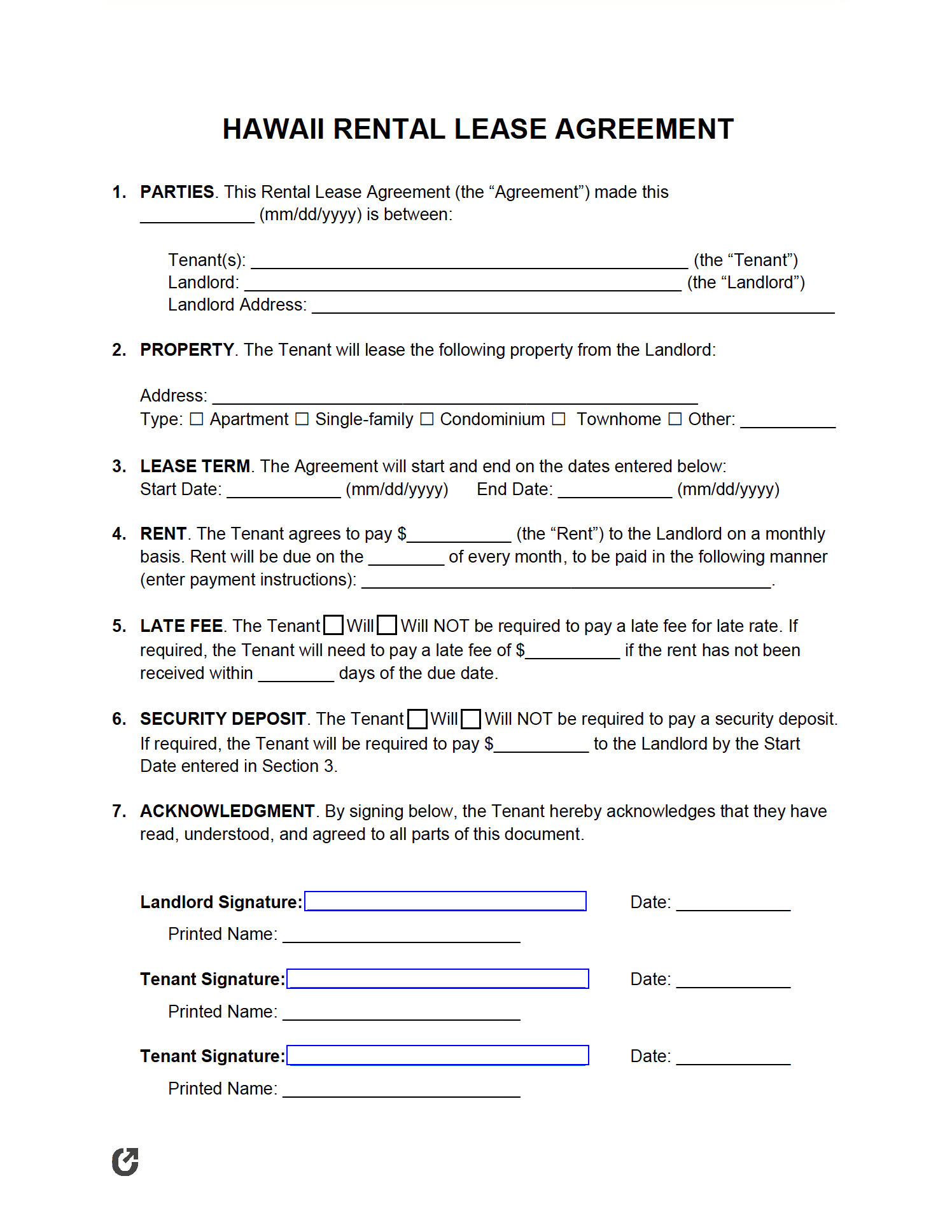Hawaii Rental Lease Agreement Templates
The Hawaii Rental Lease Agreements are written forms that bind a landlord and tenant(s) into a deal in which a building, room, or apartment is rented in exchange for regular payments. Leases can extend anywhere from a few months to five (5) or more years, depending on the renting situation. Although each form is different in its own right, the contents of the documents cover many of the same types of information, which includes:
- Utility responsibilities,
- Rent amount ($),
- Lease term,
- Eviction, and
- Party contact information (to name a few).
Types (6)
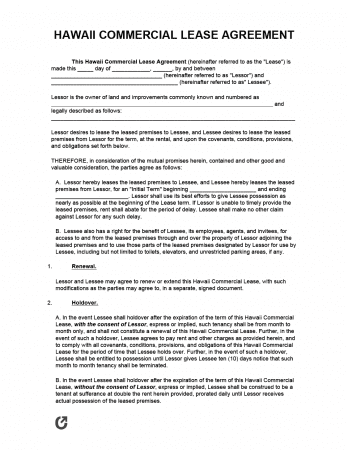 Commercial Lease Agreement – A contract signed between a landlord and a business for the rental of a property for retail, industrial, office, dining, and similar purposes. Can be used as a NNN, Modified Gross, or Gross contract.
Commercial Lease Agreement – A contract signed between a landlord and a business for the rental of a property for retail, industrial, office, dining, and similar purposes. Can be used as a NNN, Modified Gross, or Gross contract.
Download – Adobe PDF, Word (.docx)
 Lease to Own Agreement – Establishes the necessary conditions for a landlord to sell their property to tenants at the end of the lease term.
Lease to Own Agreement – Establishes the necessary conditions for a landlord to sell their property to tenants at the end of the lease term.
Download – Adobe PDF, Word (.docx)
 Month-to-Month Lease Agreement – A short-term lease that can be terminated with minimal notice; typically thirty (30) days.
Month-to-Month Lease Agreement – A short-term lease that can be terminated with minimal notice; typically thirty (30) days.
Download – Adobe PDF, Word (.docx)
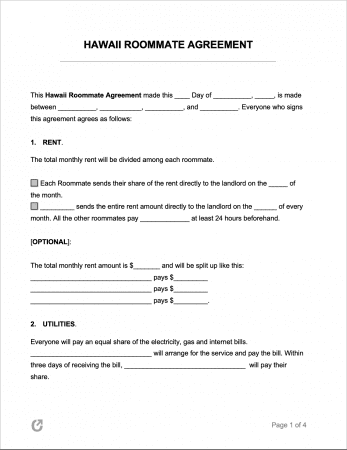 Roommate Agreement – Provides guidelines about the conduct of roommates in a shared rental dwelling, as well as outlining matters like rent and utility payments.
Roommate Agreement – Provides guidelines about the conduct of roommates in a shared rental dwelling, as well as outlining matters like rent and utility payments.
Download – Adobe PDF, Word (.docx)
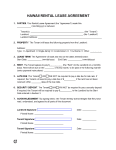 Standard Residential Lease Agreement – The most commonly used lease type. Used for protecting the rights of the landlord and tenant(s).
Standard Residential Lease Agreement – The most commonly used lease type. Used for protecting the rights of the landlord and tenant(s).
Download – Adobe PDF
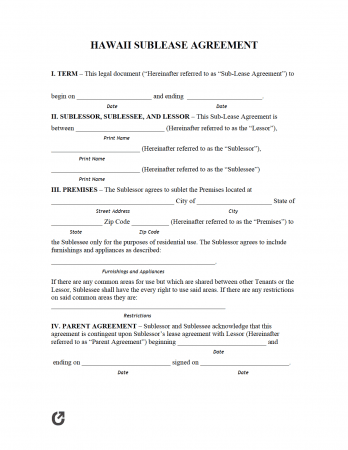 Sublease Agreement – Allows a tenant (who is locked into a lease) the ability to set binding rules and conditions that a new tenant has to follow for the remaining lease term.
Sublease Agreement – Allows a tenant (who is locked into a lease) the ability to set binding rules and conditions that a new tenant has to follow for the remaining lease term.
Download – Adobe PDF, Word (.docx)
What is a Hawaii Lease Agreement?
A Hawaii Lease Agreement is a contract used to provide legal protections to both landlords and tenants. It achieves this by imposing certain legal obligations on each party to uphold. Once a contract is signed it becomes legally-binding, so landlords should conduct due diligence when taking on new tenants by requiring them to fill out a rental application form.
State Laws & Guides
Laws: Title 28 Part 521 (Residential Landlord-Tenant Code)
Landlord-Tenant Guides / Handbooks
- Hawaii Landlord-Tenant Handbook.pdf
- Hawaii Tenant Handbook.pdf
- Landlord Information Packet.pdf
- Renting Residential Real Property Brochure.pdf
When is Rent Due?
Per § 521-21(b), rent is due at the time and place agreed to by both parties. Unless otherwise stated, rent is payable at the start of any term of one month or less, or in equal monthly installments payable at the beginning of each month for longer terms. There is no grace period required per state law.
Landlord’s Access
Emergency (§ 521-53(b)): Landlords do not need to provide tenants notice to enter in the event of an emergency.
Non-Emergency (§ 521-53(b)): Landlords can only enter during reasonable hours and have to give tenants a minimum of two (2) days’ notice prior to entering (unless it is impractical to do so).
Landlord’s Duties
The duties landlords are required to uphold for the full course of the lease are as follows (per § 521-42):
- For multi-housing units only: 1) provide constant running water as reasonably required (unless not required by law), 2) ensure tenants have access to bins/garbage containers for the disposal of garbage and rubbish, and 3) keep common areas in a clean and safe condition;
- Make any and all repairs as necessary in order to keep the rental unit in a habitable condition;
- Maintain compliance with all relevant building and housing laws that relate to the health and safety of occupants;
- Ensure all plumbing, electrical, and other systems/appliances supplied to tenants are in good working order.
Tenant’s Duties
Hawaii § 521-51 states the obligations/duties of tenants as the following (does not include the obligations as stated by the lease agreement):
- Keep all included appliances, furniture, systems, and other facilities clean and in good condition, normal wear and tear excluded;
- Throw away garbage and other trash in a manner that is cleanly and safe;
- Comply with applicable building/housing codes relating to health and safety, and maintain compliance with all rules and obligations in accordance with § 521-52;
- Don’t allow anyone on the property (including the tenants themselves) to damage or destroy any part of the property, unless the person(s) on the property were not permitted to be there by the tenants;
- Use all appliances and systems the way they were designed to be used; and
- Keep their rental unit both clean and safe as permittable.
Required Disclosures
- Inventory Checklist (§ 521-42): Prior to the tenants moving in, landlords are required to conduct an inventory of the premises and provide tenants with a written record of it that specifies the condition of the premises and any furnishings or appliances provided.
- Lead-Based Paint Disclosure: In accordance with federal law, landlords are required to disclose lead-based paint hazards in the rental property. Additionally, they must supply a pamphlet regarding about lead-based hazards to tenants.
- Names and Addresses (§ 521-43(a)): The names and addresses of the owner of the premises as well as anyone authorized to manage the premises must be disclosed.
- Tax (§ 521-43(h)): Landlords must notify tenants of their general excise tax number for the purpose of filing for a low-income tax credit.
- Copy of the Lease (§ 521-43): Landlords must provide each tenant with a copy of the signed lease.
Security Deposits
Statutes: § 521-44
Maximum: The maximum security deposit cannot exceed one (1) month’s rent. Tenants with pets may be required to pay an additional fee on top of the standard security deposit.
Returning to Tenant: The deposit must be returned within fourteen (14) days from the termination date.
Deposit Interest: Not required per the Landlord-Tenant handbook.
Uses of the Deposit: Per Hawaii law, landlords can remove all (or a portion of) a tenant’s security deposit for the following reasons:
- To repair damage to the rental caused by the tenant(s) (regardless if it was accidental or purposeful) and to cover the cost of un-returned keys, garage door openers, and other keys/fobs provided to tenant(s) at the beginning of the lease;
- To pay for the cleaning of the rental in order to return it to the condition it was in when the lease first began;
- Recover damages that resulted from a tenant exiting the lease early;
- To repair pet-caused damages to the rental; and
- To pay for unpaid utility bills that were originally the responsibility of the tenant(s).
